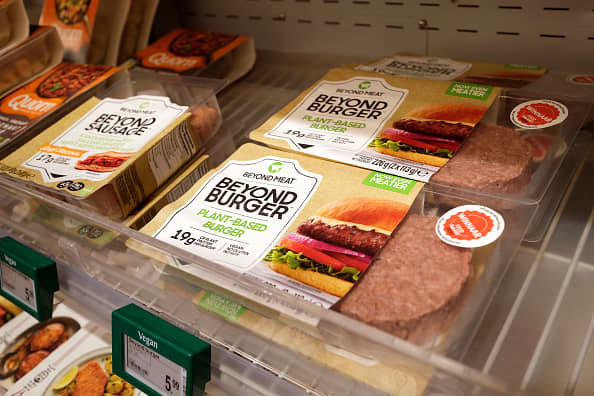Beyond Meat on Thursday reported a wider-than-expected loss and shrinking revenue for its fourth quarter as it shifts its focus from slumping grocery sales to scaling its production for large fast-food launches.
The new year kicked off with the debut of KFC Beyond Fried Chicken, while February brought an expanded test for McDonald’s McPlant burger, which is made with Beyond’s beef patty substitute.
Despite the potential new business and a plan to cut back on spending, the company’s stock fell 11% in extended trading as its 2022 revenue outlook was disappointing.
Here’s what the company reported in the three months ended Dec. 31 compared with what Wall Street was expecting, based on a survey of analysts by Refinitiv:
- Loss per share: $1.27 vs. 71 cents expected
- Revenue: $100.7 million vs. $101.4 million expected
Beyond reported fourth-quarter net loss of $80.37 million, or $1.27 cents per share, which is wider than its loss of $25.08 million, or 40 cents per share, a year earlier. Analysts surveyed by Refinitiv were forecasting a loss of 71 cents per share.
Executives said higher costs came from the company’s choice to lean on more expensive co-manufacturing facilities rather than its own manufacturing plants for production. In addition to costing more, the shift also meant paying higher transportation and logistics fees.
“This allocation was the right decision, given the long-term importance of the supported projects,” CEO Ethan Brown said on the conference call with analysts.
Brown said in a statement that the company expects to “substantially moderate” the growth of its operating expenses in 2022, which could help it return to profitability.
“The investments we made in our team, infrastructure, and capabilities across the U.S., EU, and China, as well as extensive product scaling activities for key strategic partners, weighed heavily on operating expenses and gross margin during a fourth quarter and year that were already impacted by lower than expected volumes,” Brown said in the statement.
During the quarter, net sales dropped 1.2% to $100.7 million, falling short of expectations of $101.4 million.
U.S. grocery sales fell 19.5% to $49.98 million. Beyond attributed the slump to softer demand, increased discounts, loss of market share and five fewer shipping days compared with the year-ago period. After experiencing soaring demand in 2020, the company’s largest division by revenue has struggled to keep up that pace of growth.
On the conference call with analysts, Brown attributed some of the slowing growth to the company’s decision to focus on its restaurant business, rather than creating new grocery products, which typically drive demand. However, he said the return of in-store sampling, expanded distribution and new marketing should help revive grocery sales.
Brown also teased the coming launch of a product through the company’s joint venture with PepsiCo, which will reportedly be meat-free jerky. CFO Phil Hardin said the new product uses an “expensive process” that will drag down first-quarter profits, although costs should improve later in the year.
U.S. food service saw its sales climb 34.7% in the quarter to $20.63 million. Outside Beyond’s home market, international sales rose 22.6% to $30.07 million across both grocery and food service.
This marks the second consecutive quarter that Beyond has disappointed investors and analysts with its losses and revenue. The company said its third-quarter results were hurt by a number of factors ranging from the delta variant to distribution issues to a $1.9 million write-off tied to water damage at one of its plants.
Still, its fourth-quarter revenue falls within the outlook it provided to analysts in November of $85 million to $110 million as it forecast that some of the same operational challenges would drag down its results.
For 2022, Beyond is forecasting revenue of $560 million to $620 million, up 21% to 33% compared with the prior year. That outlook falls slightly below Wall Street’s net sales forecast of $637.3 million. Brown also said the company expects higher costs for the first half of 2022, although it will scale back on hiring and other spending.
